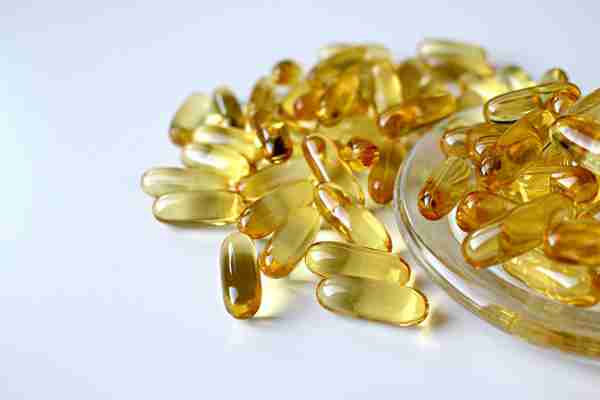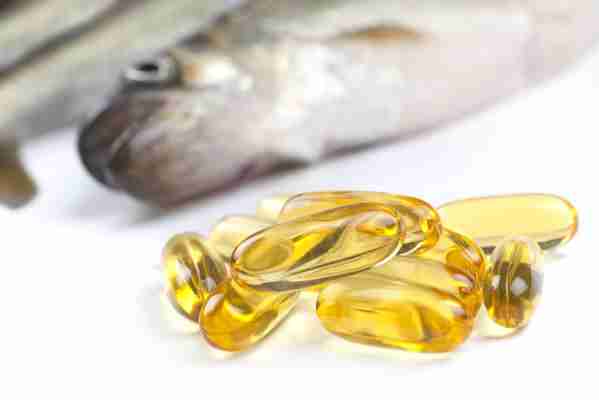Omega-3: A User’s Guide
Difference Between Fish Oil and Omega 3
The main difference between fish oil and omega 3 is that the fish oil is an oil produced from the fats or tissues of a fish whereas omega 3 is a fatty acid that is in polyunsaturated form. Furthermore, fish oil contains two forms of omega 3: EPA and DHA, while the three forms of omega 3 are alpha-linolenic acid (ALA), eicosapentaenoic acid (EPA), and docosahexaenoic acid (DHA).

Fish oil and omega 3 are two types of food components with a lot of benefits to the body, including the health of the heart.
Key Areas Covered
1. What is Fish Oil
– Definition, Sources, Cod Liver Oil
2. What is Omega 3
– Definition, Forms, Benefits
3. What are the Similarities Between Fish Oil and Omega 3
– Outline of Common Features
4. What is the Difference Between Fish Oil and Omega 3
– Comparison of Key Differences
Key Terms
Alpha-linolenic Acid (ALA), Eicosapentaenoic Acid (EPA), Docosahexaenoic Acid (DHA), Fish Oil, Omega 3
What is Fish Oil
Fish oil is a health supplement that mainly contains omega 3 fatty acids. The two main types of fatty acids in fish oil are EPA and DHA. Fish oil is extracted from the flesh of fatty fish such as tuna, herring, anchovies, mackerel, and salmon. Actually, fish do not produce omega 3 inside their body. However, they get it by consuming phytoplankton that consumes microalgae. Thereby, the original source of omega 3 is microalgae.
An important subtype of fish oil is cod liver oil extracted from the liver of the codfishes such as Atlantic cod and Pacific cod. Cod liver oil is a good source of EPA, DHA, and vitamin A and D. The most important feature of cod liver oil is its anti-inflammatory effect.
What is Omega 3
Omega 3 is a polyunsaturated fatty acid that reduces the amounts of triglycerides in the body, lowering the risk of death, heart attack and stroke. It also helps in regulating the heart rhythms, lowering the risk of arrhythmia and atherosclerosis. It has an anti-inflammatory effect as well. However, omega 3 cannot be produced by the human body; hence, it has to be taken into the body through the diet or as supplements
The three main forms of omega 3 are alpha-linolenic acid (ALA), eicosapentaenoic acid (EPA), and docosahexaenoic acid (DHA). ALA comes from plant sources such as vegetable oils (canola, soybean oil, etc) and walnuts. Both EPA and DHA mainly come from fish and they are more powerful than ALA. The current recommendation of omega 3 by WHO is 0.3-0.5 g of EPA and DHA and 0.8-1.1 g ALA per day.
The other two types of omega fatty acids are omega 6, which is polyunsaturated, and omega 9, which is monosaturated. Omega 6 comes from vegetable oils, nuts, and seeds while omega 9 comes from olive oil, canola oil, safflower oil, avocado, and nuts such as peanuts and almonds.
Similarities Between Fish Oil and Omega 3
Fish oil and omega 3 are important health supplements.
Both have benefits for heart health, mental health, inflammation, pregnancy as well as breastfeeding.
Difference Between Fish Oil and Omega 3
Definition
Fish oil refers to a fatty oil obtained from oily fish, which contains a large amount of unsaturated fatty acids called omega 3 while omega 3 refers to a class of essential fatty acids, which lowers the levels of cholesterol and LDL.
Source
The source of Omega 3 in fish oil is the microalgae while omega 3 comes from either fish or plant sources such as vegetable oils and walnuts, flaxseed, and dark leafy greens.
Forms
Furthermore, the fish oil contains EPA and DHA while the three forms of omega 3 are APA, EPA, and DHA.
Conclusion
Fish oil is a source of omega 3. It is produced from the flesh of fatty fish. On the other hand, omega 3 is a polyunsaturated fatty acid, which comes in three forms ALA, EPA, and DHA. ALA is based on plant sources while EPA and DHA are based on fish. The main difference between fish oil and omega 3 is their correspondance.
Reference:
1. “Cod Liver Oil vs. Fish Oil: Differences, Benefits, Risks, and Dosage.” Healthline, Healthline Media, Available Here
2. “Omega-3 Fish Oil Supplements for Heart Disease.” WebMD, WebMD, Available Here
Image Courtesy:
1. “fish-oil-capsule-yellow-oil-capsule-1915424” (CC0) via Pixabay
2. “ALAnumbering” By en:User:Edgar181 – en:Image:ALAnumbering.png, re-drawn in BKchem+perl+inkscape+vim (Public Domain) via Commons Wikimedia
3. “EPAnumbering” By Edgar181 – Own work (Public Domain) via Commons Wikimedia
4. “DHAnumbering” By Edgar181 – Own work (Public Domain) via Commons Wikimedia
Fish Oil vs. Eating Fish: What's The Best Source of Omega-3s?
The convenience of a pill can’t be beat. At least, that’s how it must seem to many Americans. Instead of eating the recommended two servings of fish per week, many people get their omega-3s by taking a fish oil supplement. But is this as effective as getting your essential fatty acids straight from the source?

What Are Omega-3s?
Omega-3 fatty acids have many health-boosting benefits. They lower triglycerides, which afffect your blood pressure and cholesterol levels, curb stiffness and joint pain and may help to reduce the symptoms of ADHD and depression. Furthermore, omega-3s help prevent heart disease, heart attacks and stroke. Research is even being done on the effectiveness of omega-3s in lowering the risk of cancer, dementia and Alzheimer’s disease. Although the human body can make most of the fats it needs from other fats or raw materials, that isn’t the case for omega-3s; the body must get them from a direct food source or a supplement.
Does Fish Pose a Risk?
Fish is the best natural source of omega-3 fatty acids, but some people are concerned about other, potentially harmful ingredients that may be in fish such as mercury, PCBs (polychlorinated biphenyls) and environmental contaminants. However, it’s usually just large, predatory fish such as shark, swordfish or king mackerel that may contain these substances. These fish usually aren’t very common in grocery stores or on menus.
By choosing seafood such as salmon, Tilapia, shrimp and yellowfin tuna, you can receive all the health benefits of fish without having to worry about taking in harmful components like mercury. Studies have found that the benefits of eating fish far outweigh any potential risks among the general population.
Supplementing with Supplements
While taking fish oil supplements may seem easier than eating fish twice a week, they have a more limited fatty acid profile than whole fish and don’t contain selenium, which reduces mercury toxicity. While they often contain higher levels of EPA and DHA, supplements also do not contain other fats present in fish that might activate processes required to absorb these fatty acids found in omega-3s.
Research is inconclusive about the benefits of taking omega-3s in supplement form. A study in 2003 did find a link between these supplements and reduced risk of prostate cancer, though its results have not been replicated. A different study found that taking omega-3 supplements did nothing to reduce one’s risk of heart attacks or strokes, while others found that taking omega-3 supplements did not provide any significant health benefits.
Despite the fact that omega-3s are best when sourced from food, there are times when omega-3 supplements can be helpful or even necessary. Those who have coronary artery disease or elevated triglyceride levels may not get enough omega-3 by their diet alone and doctors may recommend that they take omega-3s supplements on top of eating fish twice weekly.
The Evidence Is In
Consuming omega-3 fatty acids through fish has more health benefits than taking supplements. If you’ve been avoiding fish because you don’t like the taste, why not try some new recipes? We recommend using Tilapia—not only does it contains omega-3s and protein, but it lacks the distinct “fishy” taste that most other seafood has. Grill, bake, cook or fry your way to a healthier you this year.
Image Credits: V.J. Matthew / Shutterstock, Tarttong / Shutterstock, Valeri Potapova / Shutterstock
Omega-3: A User’s Guide
Omega-3 fatty acids quiet inflammation and are important for heart health. Here are some key facts you should know. (For more information on Omega 3 benefits, check out our module on dietary fats.)
Best to eat a minimum of 2 servings of fish per week.
Choose wild-caught when possible, so that you can reduce your exposure to toxins. Omega-3 content varies widely among fish: salmon is rich in Omega-3s while tilapia has extremely little.
If more Omega-3s are needed, over-the-counter fish oil supplements are often used. But dosing of fish oil can be confusing.
The active ingredients of fish oil are EPA and DHA, However, the amount of fish oil listed on the FRONT label of the supplement bottle (usually 1,000 mg) is the total oil in the capsule, only a small fraction of which may be EPA and DHA—perhaps as little as 25%.
Look at the nutrition facts on the BACK of the bottle and check the EPA and DHA per pill, and take enough of the pills to add up to the prescribed dose.
For example, if your healthcare provider prescribes 1,000 mg of fish oil, what is usually intended is 1,000 mg total of EPA and DHA. Generally, cheaper fish oils are less concentrated in EPA and DHA.
For vegetarians, flax, chia seeds, and walnuts are good sources.
However, plant omega-3s are not as efficiently used by the body as fish oil because they require an added chemical conversion to the active EPA and DHA.
Krill oil from shrimp-like animals is lower in EPA and DHA than fish oil but is absorbed a bit better.
Downsides are much higher cost and lack of studies using krill oil to reduce attacks.

